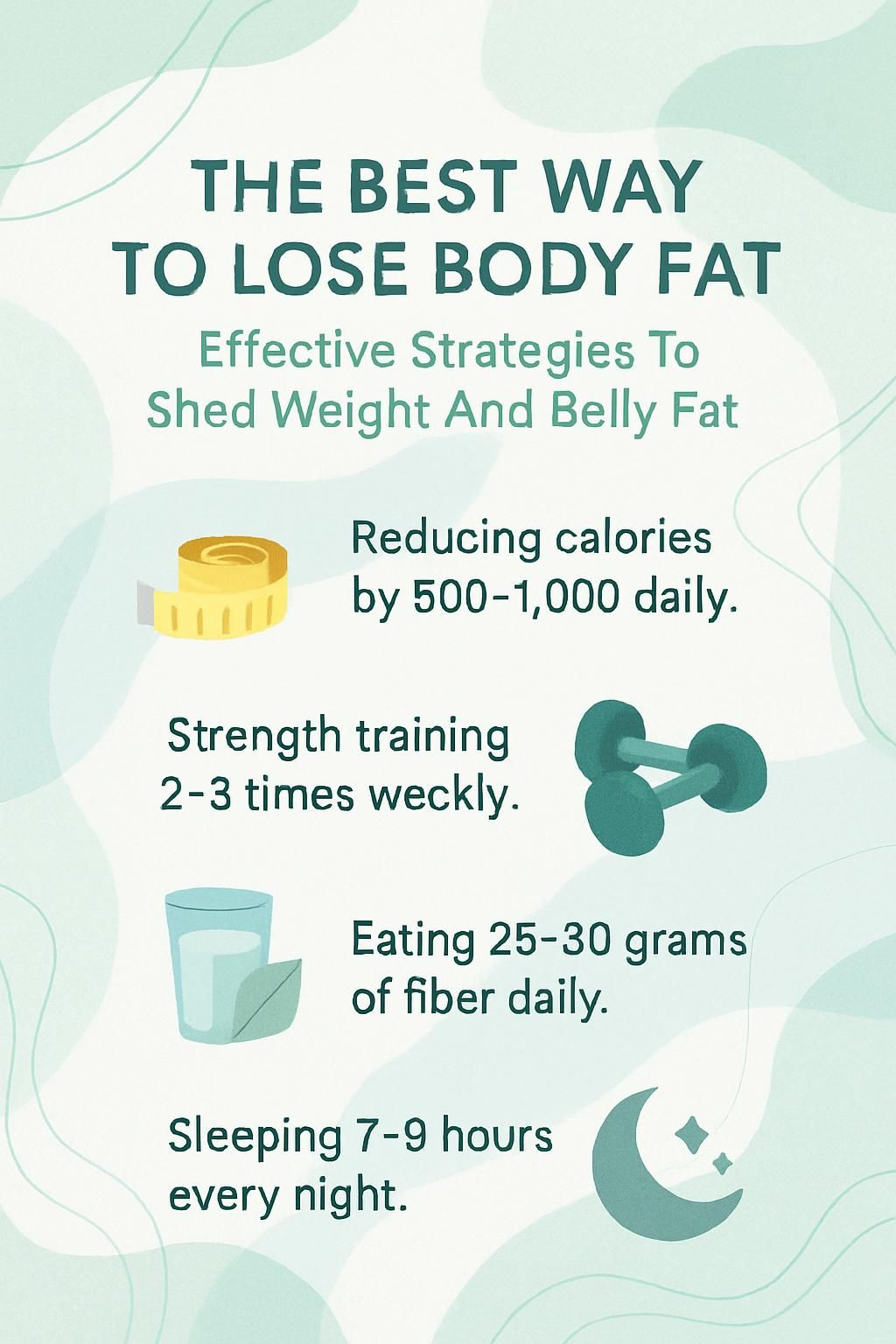The Best Way To Lose Body Fat: Effective Strategies To Shed Weight And Belly Fat
Our Nutrition Assistant AI Suite will transform your body. You will lose fat, get toned, and build muscle. Gain confidence and optimal health.
If losing weight or trimming belly fat has felt hard, you are in good company. Extra body fat, especially around the abdomen, raises the risk of heart disease and type 2 diabetes. This guide gives you clear, evidence-based steps for weight loss. You will learn how diet, strength training, and simple lifestyle changes help you lose body fat and keep it off.
Start making smart choices for a healthier future, then build progress one small step at a time.
Key Takeaways
- Cutting daily calories by 500 to 1,000 can lead to losing 1 to 2 pounds per week, a pace supported by the CDC.
- Strength training 2 to 3 times weekly plus at least 150 minutes of aerobic exercise helps reduce total and belly fat, as Johns Hopkins research reported in 2012.
- High protein intake, about 0.8 to 1 gram per pound of body weight, and 25 to 30 grams of fiber daily can protect lean tissue and curb overeating.
- Better sleep, stress control, and hydration improve hormone balance, reduce cravings, and support steady activity.
- Methods like intermittent fasting or using probiotics may help but should be guided by a healthcare professional; fast fad diets raise health risks.

Understanding Body Fat

Body fat comes in a few types and has important jobs. Knowing the differences helps you choose better ways to lose weight and protect your health. Think of fat as both a fuel tank and a safety pad.
What are the different types of body fat?
You have two main types of fat. Subcutaneous fat sits under your skin and is the kind you can pinch on your arms, legs, or belly. It helps regulate body temperature and stores energy.
Visceral fat is deeper and surrounds your organs inside the abdomen. Too much visceral fat raises the risk of heart disease, insulin resistance, metabolic syndrome, certain cancers, and high blood pressure. A growing waistline often signals more visceral fat.
Waist circumference is a simple risk check. Aim for less than 35 inches for women and less than 40 inches for men. A 2012 Johns Hopkins study found that reducing abdominal fat improves blood flow and artery function.
Choose whole grains, lean proteins, and high fiber vegetables. Cut back on processed foods and added sugars. These swaps help you lower visceral fat over time.
Visceral belly fat poses a greater threat to health than the padding beneath the skin, explains Dr. Kerry Stewart from Johns Hopkins Medicine.
Why does the body need fat?
Fat, also called adipose tissue, stores energy for later use. It cushions and protects organs like your liver and lungs. Fat tissue also makes hormones such as leptin, which signals fullness, and it interacts with insulin, the hormone that helps move sugar from your blood into cells.
Your nerves need fatty acids to work well. Fat helps you absorb vitamins A, D, E, and K because these nutrients dissolve in fat. Balanced fat intake supports blood vessel health so oxygen-rich blood flows to muscles and other tissues.
Too little fat can weaken your immune system and dry your skin. Too much can push your body mass index into an unhealthy range. Eating the right kinds of fats, along with a balanced diet and exercise, supports long-term weight maintenance.
The Importance of Losing Excess Body Fat
Excess fat stresses your heart, blood vessels, and metabolism. Dropping even a modest amount can reduce disease risk and help you feel better day to day. Think of fat loss as lightening your body’s load.
What health risks come with excess body fat?
Carrying extra fat raises the risk of heart disease, type 2 diabetes, and some cancers. A larger waistline strongly links to higher rates of cardiovascular disease and diabetes. Visceral fat can trigger inflammation that damages blood vessels and worsens cholesterol levels.
Doctors also see connections with high blood pressure, breathing problems, and poor sleep quality. Over time, hormonal shifts may increase hunger, making weight control tougher. Many people feel more fatigue because excess fat strains multiple body systems.
How does losing fat improve overall health?
Losing fat improves blood vessel function and supports heart health. In a 2012 study, people who reduced belly fat with either a low-fat or low-carb diet showed better artery function. Even moderate weight loss can lower the risk of type 2 diabetes and heart disease.
Many people sleep better as body weight drops, especially when belly fat declines. You may also notice more energy for daily tasks after losing as little as 10 pounds. That extra energy makes it easier to stay active and build habits that keep the weight off.
Dietary Strategies to Lose Body Fat
Nutrition drives steady fat loss. A simple, balanced plan beats strict rules most days. Treat food choices like daily practice, not punishment.
How can reducing calorie intake help fat loss?
Fat loss depends on a calorie deficit. That means you eat fewer calories than your body uses. Your body then taps stored fat for energy.
- Cut 500 to 1,000 calories per day to lose about 1 to 2 pounds per week, a CDC guideline.
- Use apps or a food journal to track meals and drinks so intake stays clear.
- Swap convenience foods and soft drinks for fruit, vegetables, and lean protein.
- Choose whole grains instead of refined grains like white bread to feel full longer.
- Use portion control, even with healthy foods, to prevent overeating.
- Small habits help. For example, skipping one daily sugary drink can move the scale over time.
After setting a calorie target, dial in protein so you keep muscle while you lose fat.
Why focus on protein-rich foods?
Protein helps you keep lean muscle while dieting. Aim for about 0.8 to 1 gram per pound of body weight per day during fat loss. Beans, lentils, yogurt, eggs, fish, and lean meats are strong options.
People on higher protein, lower carbohydrate plans often keep more lean tissue than those on low-fat plans. More lean tissue means you burn more calories at rest, which supports long-term weight management. Protein also keeps you full, which reduces cravings for processed snacks.
What are the benefits of increasing fiber consumption?
Dietary fiber helps you feel full on fewer calories. A daily target of 25 to 30 grams supports satiety and better weight control. Four servings of vegetables and three servings of fruit can help you reach that goal.
Fiber slows digestion so your body has time to sense fullness. That helps you avoid overeating and snacking on sugary foods. Many people also notice more regular digestion, which supports comfort and consistency during weight loss.
How do healthy fats aid fat loss?
Healthy fats, such as those in olive oil, avocados, and nuts, support hormone balance. Hormones like leptin and insulin help control whether your body burns or stores fat. When these signals work well, your metabolism stays active even while you reduce calories.
Unsaturated fats may improve weight control compared with very low-fat diets. They also help meals feel satisfying, which makes a calorie plan easier to follow. A reasonable range is 25 to 35 percent of daily calories from healthy fat sources.
Try simple swaps. Use a drizzle of olive oil instead of creamy dressings, or have a small handful of almonds as a snack. Keep portions moderate and pair them with regular activity to prevent extra calories from creeping in.
Why limit processed and sugary foods?
Processed foods and added sugars can spike blood sugar, then drive hunger later. This cycle often leads to more belly fat. People who consume many added sugars face higher risks for obesity and high cholesterol.
Replace sugary drinks with water. Add lemon or lime for flavor without calories. Federal guidelines recommend limiting added sugar because many packaged snacks, desserts, cereals, and fast food items contain high amounts. Whole fruit is different since fiber slows sugar absorption.
Swapping processed foods for whole foods is one of the best ways to lose fat and protect heart health.
Effective Exercise Routines for Fat Loss
Exercise raises your daily calorie burn and strengthens your heart and muscles. A mix of strength work and cardio helps reduce belly fat and total body fat. Think of training as turning up your body’s internal engine.
How does strength training help reduce fat?
Strength training builds muscle, which burns more calories even at rest. When you lift weights 2 to 3 times per week, your body uses extra energy to repair and grow muscle. That raises your resting metabolic rate and supports fat loss.
Blend strength work with cardio like walking or cycling for the best results. This combination lowers obesity risk and promotes steady reductions in body weight. Many people notice their waistline shrinking faster when they add short resistance sessions each week.
What aerobic exercises are best for fat loss?
Aerobic exercise, or cardio, is key for fat loss. Aim for at least 150 minutes of moderate activity each week to support healthy weight control and fitness.
- Brisk walking raises your heart rate and is easy to start. Try 30 minutes most days.
- Running burns more calories per minute, which can speed up weight loss.
- Cycling is joint friendly and works well indoors or outdoors.
- Swimming trains your whole body and is gentle on knees and back.
- Jump rope quickly boosts heart rate and aerobic capacity in short bursts.
- Rowing works upper and lower body and increases post-workout calorie burn.
- Group classes, such as Zumba or step, add fun and structure to your routine.
- Hiking adds variety and challenges big muscle groups for extra calorie burn.
Joining a group class can keep you consistent. Tracking sessions with a simple app helps you see progress and stay engaged.
What is High-Intensity Interval Training (HIIT) and how does it burn fat?
HIIT alternates short, hard bursts of exercise with brief recovery. For example, sprint for 30 seconds, then walk for 60 seconds. Repeat for 10 to 20 minutes. Many sessions last under 30 minutes.
HIIT can burn more calories in less time than steady cardio. After intense work, your body uses extra oxygen to recover. This effect, called excess post-exercise oxygen consumption, or EPOC, keeps your calorie burn elevated for a while after the workout.
Choose HIIT if you need an efficient plan. Two sessions per week can noticeably improve fitness and help reduce belly fat.
What role does cardio play in losing body fat?
Cardio increases energy use, which supports a calorie deficit. National guidelines suggest 150 minutes of moderate or 75 minutes of vigorous cardio weekly. Small habits help too. Take the stairs, park farther away, or walk during TV breaks.
Many people add a daily walk after dinner. This simple routine can reduce stress, ease cravings, and support sustained fat loss over time.
Lifestyle Changes to Support Fat Loss
Small daily habits create big results over months. Think of these changes as your support system for fat loss.
How does quality sleep affect fat loss?
Good sleep helps your metabolism and reduces fat storage. Aim for 7 to 9 hours each night. Poor rest raises hunger hormones like ghrelin and lowers leptin, the fullness signal. That mix makes cravings for high calorie foods more likely.
Better sleep also supports your energy and your mood. You will find it easier to stay active when you feel rested. Many people notice that losing belly fat leads to fewer nighttime breathing issues and deeper sleep.
Simple steps work. Set a consistent bedtime, dim screens an hour before sleep, and keep your room dark and cool.
Summary:
- Sleep shapes appetite hormones that influence cravings.
- Target 7 to 9 hours for better fat loss.
- Quality rest boosts daytime energy for activity.
- Less belly fat often improves sleep quality.
- Consistent routines reduce late-night snacking.
| Factor | Effect on Fat Loss |
|---|---|
| Duration (hours/night) | Best range is 7 to 9 |
| Cravings | Rise with poor sleep |
| Physical Activity | Improves with quality rest |
| Hormone Balance | More stable with enough sleep |
What are effective ways to manage stress for fat loss?
Stress can raise cortisol, a hormone that encourages belly fat storage. Use simple tools to protect your progress.
- Walk or jog to lower stress and support better blood sugar control.
- Practice short daily mindfulness or yoga sessions. A review in JAMA Internal Medicine reported benefits for stress reduction (Goyal et al., 2014).
- Spot your triggers and plan responses. Self-awareness lowers unplanned snacking.
- Ask a healthcare professional for support if stress feels heavy or constant.
- Protect sleep with a regular schedule since poor sleep raises cravings (NHLBI, 2022).
- Limit late caffeine to reduce evening cortisol spikes.
- Build social support. Strong networks help blunt chronic stress.
- Stay hydrated. Even mild dehydration can affect mood and appetite.
- Include omega-3 fats from fish or flaxseed, which may help hormone balance.
Quick movement breaks during busy days can calm nerves and reduce the pull of sugary snacks.
Why is consistency in physical activity important?
Daily movement keeps calorie burn steady and builds lasting routines. The CDC suggests 30 to 60 minutes of moderate to vigorous exercise most days. Even short sessions add up across the week.
Consistency prevents the regain that follows on-and-off efforts. It supports heart health, helps manage genetics you cannot change, and improves energy for work and home life.
How does hydration impact fat loss?
Water helps your body run well during weight loss. It supports metabolism, digestion, and temperature control. Drinking water before meals can reduce hunger, which helps you manage portions.
Replacing one 12-ounce soda with water saves about 150 calories a day. Over time, that change can lead to meaningful weight loss. As your body burns fat, you exhale more carbon dioxide and release water. Staying hydrated helps these processes work smoothly.
Make water your default drink at meals and keep a refillable bottle with you. Many people find better energy and fewer cravings when they stay hydrated.
Advanced Techniques for Fat Loss
Once the basics are in place, some advanced tools can help. Use them carefully and pair them with diet and exercise. Think of these tools as add-ons, not shortcuts.
What is intermittent fasting and how does it help?
Intermittent fasting uses planned eating windows. A common pattern is 16 hours fasting with an 8-hour eating window. Others choose one or two low-calorie days per week. These patterns often reduce total calories and can improve insulin sensitivity, which helps your body use stored energy better.
Some people also notice fewer hunger spikes. Talk with a healthcare professional before starting, especially if you take medicine, have diabetes, or have a history of disordered eating.
How can probiotics support fat loss?
Probiotics are helpful bacteria that support gut health. A balanced gut may improve how you process fat and reduce inflammation linked to belly fat. You can get probiotics from yogurt with live cultures, kefir, or supplements.
Some studies since 2022 suggest probiotics may reduce abdominal fat compared with no probiotics.[1] Results are usually modest. Use them as part of an overall plan that includes nutrition and activity.
[1] Reference: Clinical Nutrition Journal, “Effects of Probiotics on Body Fat Reduction”, 2022
Can vinegar enhance fat burning?
Vinegar may improve insulin sensitivity and help you feel full after meals. In a 2018 study, daily vinegar led to small weight reductions, especially around the waist, when used with healthy eating.
Try mixing apple cider vinegar into a salad dressing. Long-term success still depends on your total diet and your exercise routine. More research is needed before vinegar is considered an essential weight loss tool.
Tracking Progress and Staying Motivated
Tracking keeps you honest and motivated. Small wins add up like steps on a trail.
How do you set achievable fat loss goals?
Set goals you can reach. Aim to lose 1 to 2 pounds per week. Start with an initial target such as 5 percent of your current weight. At 180 pounds, that first goal would be 9 pounds.
Use action goals as well as outcomes. For example, plan to walk 30 minutes daily or swap your afternoon snack for fruit. Action goals make your daily plan clear and repeatable.
What are non-scale victories and why do they matter?
The scale is only one tool. Non-scale victories show real-life progress. Notice if clothes fit better, stairs feel easier, or energy lasts longer. You can also measure your waist. Under 35 inches for women and under 40 inches for men signals lower risk.
These wins keep motivation high while the scale moves more slowly. Many people stay consistent once they see daily life getting easier.
How should you monitor your food intake?
Log meals and snacks in a notebook or app. Tracking raises awareness of portions, added sugars, and fats. Many apps also show nutrition breakdowns so you can balance protein, carbs, and fat across the day.
Read food labels. Watch for added sugars and refined oils. Compare brands and choose options with better nutrition profiles. Small swaps can cut calories without sacrificing taste.
Why celebrate small milestones during fat loss?
Celebrating small milestones builds momentum. Reward yourself in healthy ways when you meet a weekly goal or see steady habits. That might mean new workout music, a relaxing bath, or a walk in a favorite park.
Post your reasons for losing weight where you will see them, like on your fridge or mirror. Share your goals with a friend who will cheer you on. Encouragement makes it easier to keep going during tough weeks.
Common Myths About Fat Loss
Myths can waste time and money. Clear facts help you focus on what works.
Is spot reduction of fat possible?
No. You cannot target fat loss to one area like arms or belly. As you lose weight, your body chooses where fat leaves first, based on genetics. Exercise will tone the muscles underneath, but it will not pick the exact place your body burns fat.
Focus on an overall plan, which means healthy eating and consistent activity. That approach lowers total body fat and, in time, reduces belly fat as well.
What is the truth about starvation mode?
Short-term calorie cuts do not trap you in starvation mode. The real issue is extreme, long-term restriction. Severe cuts can lower your metabolic rate and increase hunger. That makes sticking to a plan much harder.
Moderate and steady calorie reduction protects muscle, supports metabolism, and improves long-term results. Choose a pace you can live with week after week.
Why should you avoid fad diets and quick fixes?
Fad diets often rely on extreme rules or cutting major food groups. Many cause fast water loss, not steady fat loss. These plans rarely fit everyday life, so weight regain is common.
Trusted sources like the Mayo Clinic Diet and Harvard T.H. Chan School of Public Health favor balanced, sustainable habits over crash diets.¹ Slow progress may feel less exciting at first, but it lasts longer and protects your health.
¹ Reference: Mayo Clinic Diet Overview; “Sustainable Weight Loss Strategies,” Harvard T.H. Chan School of Public Health.
When to Seek Professional Advice
Professional support can speed progress and improve safety. If you have health conditions or feel stuck, reach out early. This content is educational and does not replace medical care.
When should you consult a nutritionist or dietitian?
Talk with a registered dietitian before starting a new plan if you have medical concerns, need tailored guidance, or struggle to make changes alone. Seek help if you have diabetes, heart disease, food allergies, or digestive issues. Clinics such as the Mayo Clinic offer evidence-based care across several locations.
How can a personal trainer assist with fat loss?
A certified trainer can set clear goals and design safe workouts for fat loss and muscle building. You may use interval training, strength circuits, or aerobic sessions that match your fitness level.
Regular check-ins build accountability and keep you on track. Research shows people working with trainers often see greater improvements in body composition than those training alone.¹⁰
¹⁰ National Center for Biotechnology Information: “Effectiveness of Personal Training on Body Composition” (2021).
What medical interventions exist for fat loss?
If lifestyle changes are not enough, medical options may help. The 2014 American College of Cardiology guideline describes evidence-based choices, including prescription medicines. GLP-1 receptor agonists such as semaglutide or liraglutide can reduce appetite and support weight loss for eligible people.
Ask your primary care doctor about referrals to weight management services through your local health system. A professional assessment will determine if medicines or bariatric surgery are appropriate. Medical care works best when combined with diet, exercise, sleep, and stress management.
Conclusion
Fat loss takes steady effort, not perfection. Start with the basics, a calorie deficit, strength training, aerobic exercise, and a healthy diet rich in protein and fiber. Limit processed foods and added sugars to protect your heart and reduce belly fat.
Track habits with a journal or app and look for non-scale wins. Set clear, realistic goals so progress feels doable each week. If you need support or have medical issues, ask a healthcare professional for guidance.
Consistency is the best way to lose weight and keep it off. Keep showing up, keep it simple, and your energy, health, and waistline will reflect the work you put in over time.
FAQs
1. What are the most effective strategies to lose body fat and reduce belly size?
Research shows that a combination of regular aerobic activity, resistance training, and a balanced diet with fewer processed foods leads to significant fat loss. Studies from the National Institutes of Health highlight that consistent exercise paired with calorie control is more effective than dieting alone.
2. How does nutrition impact weight loss and abdominal fat reduction?
Consuming whole grains, lean proteins such as poultry or fish, vegetables, fruits, and healthy fats supports steady weight loss. Data from Harvard School of Public Health indicate diets high in fiber help decrease visceral adipose tissue around the abdomen.
3. Can tracking progress improve results when trying to shed excess body mass?
Yes; monitoring food intake using journals or apps helps people stay accountable for their choices. A personal example: When I tracked my meals daily for three months, I noticed better portion control and lost two inches off my waistline.
4. Are there specific habits that support long-term maintenance after losing unwanted pounds?
Maintaining an active lifestyle through regular movement along with mindful eating prevents regaining lost weight according to studies published in Obesity Reviews. Summing up these points: sustainable routines involving physical activity and nutritious food choices play key roles in keeping off extra pounds over time.







